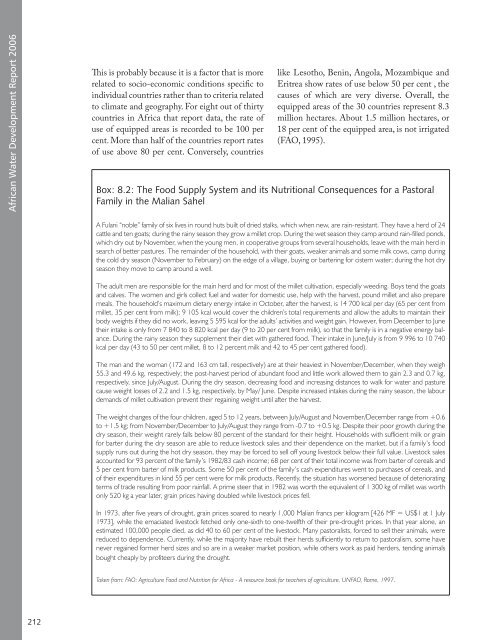African Water Development Report 2006 - United Nations Economic ...
African Water Development Report 2006 - United Nations Economic ...
African Water Development Report 2006 - United Nations Economic ...
Create successful ePaper yourself
Turn your PDF publications into a flip-book with our unique Google optimized e-Paper software.
<strong>African</strong> <strong>Water</strong> <strong>Development</strong> <strong>Report</strong> <strong>2006</strong>This is probably because it is a factor that is morerelated to socio-economic conditions specific toindividual countries rather than to criteria relatedto climate and geography. For eight out of thirtycountries in Africa that report data, the rate ofuse of equipped areas is recorded to be 100 percent. More than half of the countries report ratesof use above 80 per cent. Conversely, countrieslike Lesotho, Benin, Angola, Mozambique andEritrea show rates of use below 50 per cent , thecauses of which are very diverse. Overall, theequipped areas of the 30 countries represent 8.3million hectares. About 1.5 million hectares, or18 per cent of the equipped area, is not irrigated(FAO, 1995).Box: 8.2: The Food Supply System and its Nutritional Consequences for a PastoralFamily in the Malian SahelA Fulani “noble” family of six lives in round huts built of dried stalks, which when new, are rain-resistant. They have a herd of 24cattle and ten goats; during the rainy season they grow a millet crop. During the wet season they camp around rain-filled ponds,which dry out by November, when the young men, in cooperative groups from several households, leave with the main herd insearch of better pastures. The remainder of the household, with their goats, weaker animals and some milk cows, camp duringthe cold dry season (November to February) on the edge of a village, buying or bartering for cistern water; during the hot dryseason they move to camp around a well.The adult men are responsible for the main herd and for most of the millet cultivation, especially weeding. Boys tend the goatsand calves. The women and girls collect fuel and water for domestic use, help with the harvest, pound millet and also preparemeals. The household’s maximum dietary energy intake in October, after the harvest, is 14 700 kcal per day (65 per cent frommillet, 35 per cent from milk); 9 105 kcal would cover the children’s total requirements and allow the adults to maintain theirbody weights if they did no work, leaving 5 595 kcal for the adults’ activities and weight gain. However, from December to Junetheir intake is only from 7 840 to 8 820 kcal per day (9 to 20 per cent from milk), so that the family is in a negative energy balance.During the rainy season they supplement their diet with gathered food. Their intake in June/July is from 9 996 to 10 740kcal per day (43 to 50 per cent millet, 8 to 12 percent milk and 42 to 45 per cent gathered food).The man and the woman (172 and 163 cm tall, respectively) are at their heaviest in November/December, when they weigh55.3 and 49.6 kg, respectively; the post-harvest period of abundant food and little work allowed them to gain 2.3 and 0.7 kg,respectively, since July/August. During the dry season, decreasing food and increasing distances to walk for water and pasturecause weight losses of 2.2 and 1.5 kg, respectively, by May/ June. Despite increased intakes during the rainy season, the labourdemands of millet cultivation prevent their regaining weight until after the harvest.The weight changes of the four children, aged 5 to 12 years, between July/August and November/December range from +0.6to +1.5 kg; from November/December to July/August they range from -0.7 to +0.5 kg. Despite their poor growth during thedry season, their weight rarely falls below 80 percent of the standard for their height. Households with sufficient milk or grainfor barter during the dry season are able to reduce livestock sales and their dependence on the market, but if a family’s foodsupply runs out during the hot dry season, they may be forced to sell off young livestock below their full value. Livestock salesaccounted for 93 percent of the family’s 1982/83 cash income; 68 per cent of their total income was from barter of cereals and5 per cent from barter of milk products. Some 50 per cent of the family’s cash expenditures went to purchases of cereals, andof their expenditures in kind 55 per cent were for milk products. Recently, the situation has worsened because of deterioratingterms of trade resulting from poor rainfall. A prime steer that in 1982 was worth the equivalent of 1 300 kg of millet was worthonly 520 kg a year later, grain prices having doubled while livestock prices fell.In 1973, after five years of drought, grain prices soared to nearly 1,000 Malian francs per kilogram [426 MF = US$1 at 1 July1973], while the emaciated livestock fetched only one-sixth to one-twelfth of their pre-drought prices. In that year alone, anestimated 100,000 people died, as did 40 to 60 per cent of the livestock. Many pastoralists, forced to sell their animals, werereduced to dependence. Currently, while the majority have rebuilt their herds sufficiently to return to pastoralism, some havenever regained former herd sizes and so are in a weaker market position, while others work as paid herders, tending animalsbought cheaply by profiteers during the drought.Taken from: FAO: Agriculture Food and Nutrition for Africa - A resource book for teachers of agriculture. UNFAO, Rome, 1997.212

















